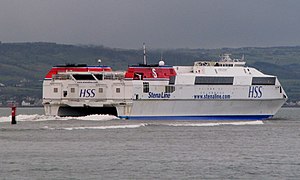HSC Stena Voyager

Stena Voyager departing Belfast
|
|
| History | |
|---|---|
| Name: | Stena Voyager |
| Owner: | Stena Recycling |
| Operator: | N/A |
| Port of registry: | London |
| Route: | Belfast–Stranraer (GB) |
| Builder: | Finnyards, Finland |
| Yard number: | 405 |
| Laid down: | May 1995 |
| Launched: | April 1996 |
| Completed: | June 1996 |
| In service: | June 1996–2011 |
| Identification: | IMO number: 9080209 |
| Status: | Scrapped |
| General characteristics | |
| Class and type: | HSS 1500 |
| Tonnage: | 19,638 GT |
| Length: | 126.6 m (415 ft 4 in) |
| Beam: | 40.0 m (131 ft 3 in) |
| Draught: | 4.8 m (15 ft 9 in) |
| Installed power: |
|
| Propulsion: |
|
| Capacity: |
|
Stena Voyager was a high-speed ferry owned by Stena Line which used to operate on their Belfast–Stranraer service. It was a member of the HSS 1500 class of high-speed ferries developed and introduced by Stena Line from 1996 onwards.
In 2013, Stena Voyager was sold for scrap. She was towed to Landskrona, Sweden, where she was broken up by Stena Recycling.
The vessel was a catamaran, and was designed with the aim of providing a comfortable and fast service. The sailing time between Belfast and Stranraer was 119 minutes.
Power was provided by four GE Aviation gas turbines in a twin combined gas and gas (COGAG) configuration. The vessel employed four Kamewa waterjets for propulsion.
The HSS class of ferries were designed to allow quick turnarounds at port. A specially designed linkspan provided ropeless mooring and allowed quick loading, unloading and servicing. Vehicles were loaded via two of the four stern doors and parked in a "U" configuration. When disembarking, vehicles drove straight off via the other two doors.
Stena Voyager was constructed by Finnyards in Rauma, Finland. Construction commenced in May 1995 and was completed in June 1996, before entering service in July 1996.
Stena Voyager spent the majority of her career sailing on her original route between Belfast and Stranraer, apart from short periods covering for her sister ships.
When the Stena Voyager was introduced on the Belfast–Stranraer route it was advertised as having a crossing time of 85 minutes, however this crossing time was not possible due to speed restrictions introduced on Belfast Lough to prevent the high waves created by the vessel when at speed. Due to the speed restrictions, the vessel's crossing time was increased to 105 minutes.
In 2008, the crossing time was increased to 119 minutes, allowing an 8% reduction in fuel consumption.
On 28 January 2009, a lorry carrying ferrous sulphate powder burst through the stern doors of the Stena Voyager shortly after departure. Because of this, the ferry had to return to Stranraer. Subsequent sailings were postponed. The cause of the accident was the driver of the lorry failing to park it in gear and to apply the handbrake. The vehicle was insufficiently secured to the ship's deck.
...
Wikipedia
